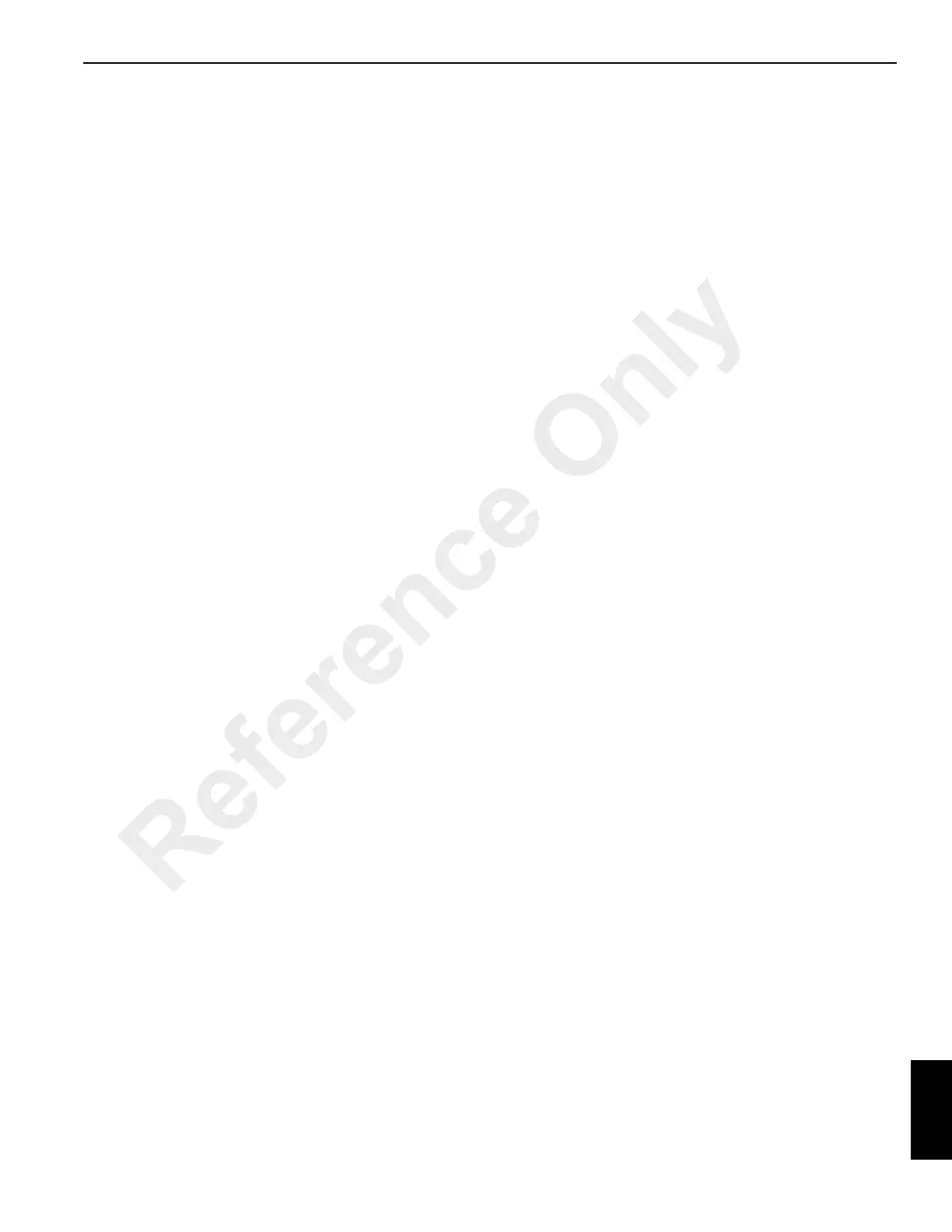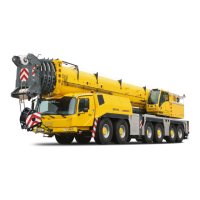GROVE 10-3
CD3340B/YB4411 STEERING SYSTEM
Published 04/07/2015 Control # 569-00
Two-wheel Steering
During two-wheel steering, the front wheels steer in the
same direction that the steering wheel turns. The rear
wheels remain in a fixed forward position.
When turning to the right, hydraulic oil under pressure from
the steering pump flows through the priority flow control
valve to the P port of the steering orbitrol in the operator’s
compartment. When the steering wheel is turned to the right,
hydraulic fluid is directed through port R of the steering
orbitrol to port P of the steering select valve. The steering
select valve has four solenoid valves. These valves are
activated by the steering select switch in the operators
compartment. When the steering select switch is placed in
the two-wheel steering mode solenoid 750 is actuated. Oil
passes through the porting of the valve block to the base end
of the front axle steering cylinder. The piston moves to the
left, extending the left cylinder rod and retracting the right
cylinder rod, creating a right turn. Return oil from the steering
cylinder flows into port L, out of port T of the steering orbitrol
and back to tank.
Four-wheel Steering
During four-wheel steering, the front wheels steer in the
direction that the steering wheel is turned, while the rear
wheels turn in the opposite direction. This mode provides an
extremely short turning radius. It allows the rear wheels to
follow the track of the front wheels, which is an advantage in
muddy or sandy conditions.
When turning to the right, hydraulic oil under pressure from
the steering pump flows through the priority flow control
valve to the P port of the steering orbitrol in the operator’s
compartment. When the steering wheel is turned to the right,
hydraulic fluid is directed through port R of the steering
orbitrol to port P of the steering select valve. The steering
select valve has four solenoid valves. These valves are
activated by the steering select switch in the operator’s
compartment. When the steering select switch is placed in
the four-wheel steering mode solenoids 749 and 752 are
actuated. Oil passes through the porting of the valve block
and out port A to the rear axle steering cylinder. Oil is
directed to the rod end of the left steering cylinder and base
end of the right cylinder, causing the rear wheels to turn to
the left. Return oil under pressure from the rear steering
cylinders flows into Port B of the steering select valve block
and out Port T to the front steering cylinder. The left rod of
the steering cylinder extends and the right rod retracts,
turning the front wheels to the right. Return oil from the front
steering cylinder flows into port L and out of port T of the
steering orbitrol and back to tank.
Crab Steering
During crab steering all the wheels steer in the same
direction. This mode allows the operator to move the
machine sideways. This is especially helpful in tight areas on
the job.
When turning sideways to the right, hydraulic oil under
pressure from the steering pump flows through the priority
flow control valve to the P port of the steering orbitrol in the
operator’s compartment. When the steering wheel is turned
to the right, hydraulic fluid is directed through port R of the
steering orbitrol into port P of the steering select valve. The
steering select valve has four solenoid valves. These valves
are activated by the steering select switch in the operator’s
compartment. When the steering select switch is placed in
the crab-steering mode solenoids 749 and 751 are actuated.
Oil passes through the porting of the valve block and out port
B to the rear axle steering cylinders. Oil is directed to the
base end of the left steering cylinder and rod end of the right
cylinder, causing the rear wheels to turn to the right. Return
oil under pressure from the rear steering cylinders flows to
Port A of the steering select valve block and out port T to the
front steering cylinder. The left rod of the steering cylinder
extends and the right rod retracts, turning the front wheels to
the right. Return oil from the front steering cylinder into port L
and out of port T of the steering orbitrol and back to tank.
Reference Only
